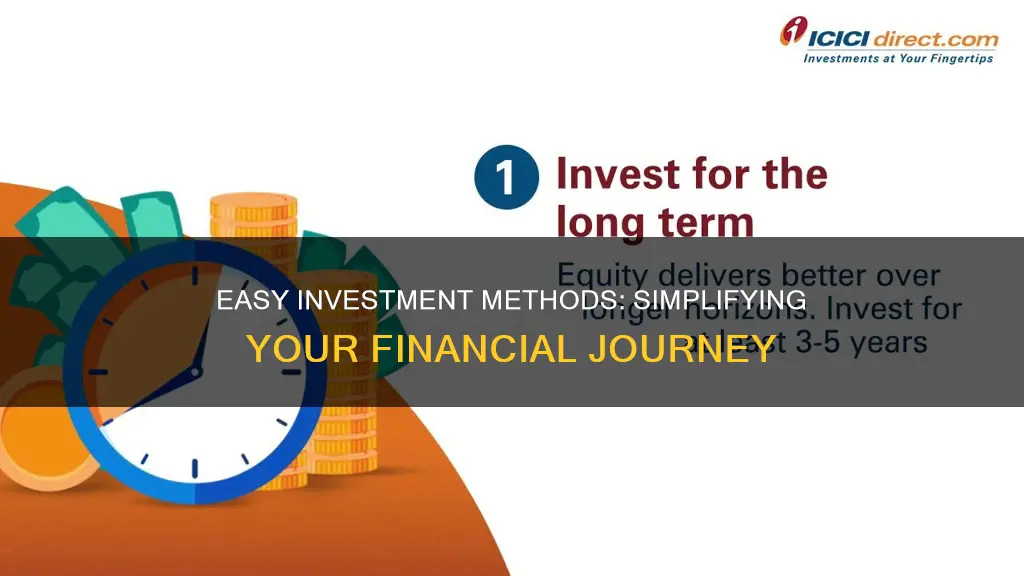
Investing your money can be a great way to build wealth over time, but it's important to understand the different investment methods available to you. The easiest investment method will depend on your financial goals, risk tolerance, and how much time and money you have to invest. Here are some of the most common investment methods to consider:
1. Passive Index Investing: This strategy involves putting your money into index-tracking mutual funds or exchange-traded funds (ETFs) that offer built-in diversification and a hands-off approach. While it may not outperform the market, it provides broad diversification and lower costs due to minimal trading and management fees.
2. Buy-and-Hold Strategy: This classic approach involves buying an investment and holding it for the long term, ideally indefinitely. It requires discipline to withstand market fluctuations but can lead to significant returns if the underlying business performs well over time.
3. Dollar-Cost Averaging: This strategy involves investing a fixed amount of money at regular intervals, regardless of market conditions. It helps to reduce the risk of timing the market and ensures you buy at an average price over time.
4. Income Investing: This strategy focuses on owning investments that produce regular cash payouts, such as dividend stocks and bonds. It provides a steady income stream and tends to be less risky than other investment methods.
5. Active Investing: This method involves actively researching and selecting individual stocks or other investments, often using technical analysis to identify market trends. It requires more time and knowledge but can potentially lead to higher returns.
6. Growth Investing: This strategy seeks to invest in emerging companies with strong growth potential, often offering unique products or services. While it carries more risk, it offers the allure of significant returns if the underlying business takes off.
7. Value Investing: Popularized by Warren Buffett, this approach involves bargain-hunting for undervalued stocks with strong long-term prospects. It requires active monitoring of the market and news to identify stocks that are temporarily out of favor.
8. Retirement Accounts: Starting with a retirement account through your employer or an individual retirement account (IRA) is a common way to begin investing. Employer-sponsored plans often include matching contributions, providing free money for your retirement savings.
9. Robo-Advisors: For beginners or those who want a hands-off approach, robo-advisors offer automated investment services. They construct and maintain a portfolio of index funds based on your risk tolerance and financial goals, providing a personalized investment plan with minimal effort.
| Characteristics | Values | |
|---|---|---|
| Investment Style | Active | Requires time, knowledge and desire |
| Passive | Requires less effort | |
| Investment Budget | $100 | Minimum amount to start a portfolio |
| $1,000 | Amount to create a diversified portfolio | |
| Risk Tolerance | High | Potential for huge, life-changing returns |
| Low | More stability | |
| Investment Options | Individual Stocks | Time-consuming, higher risk |
| Passive Investments | e.g. index funds, mutual funds | |
| Robo-advisors | Automated investment platform |
What You'll Learn

Passive index investing
This strategy is a form of passive investing, which aims to maximise returns by minimising the costs of buying and selling securities. Passive investing is typically done by investing in a mutual fund or ETF that mimics the index's holdings, either exactly or approximately.
Pros
- Lower costs due to minimal trading, research, and management fees.
- Simplicity and ease of implementation through passive funds.
- Broad diversification across multiple sectors.
- Potential for long-term growth in line with the market.
- Greater flexibility for investors to execute a buy-and-hold strategy.
Cons
- Cannot outperform the market.
- Exposure to market downturns and volatility.
- Missed opportunities in specific sectors or regions.
- Reliance on the performance of the underlying index or sector.
- Potential for tracking errors (lack of a perfect match in performance) between the fund and the underlying index.
Harvesting Salac Berries: HP Investment Strategies
You may want to see also

Dollar-cost averaging
Here's how it works:
Let's say you want to invest in Mutual Fund A, and you have $1,200 to invest this year. With dollar-cost averaging, instead of investing the full amount in one go, you would invest a smaller amount, say $100, every month for 12 months. By doing this, you are buying more shares when the price is low and fewer shares when the price is high. This helps to lower your average cost per share over time.
For example, if you invest $100 per month for 12 months, your average price per share might be $9.58, and you would own 125.24 shares. On the other hand, if you invested the full $1,200 at once, your average price per share would be $10, and you would only own 120 shares.
However, it's important to note that dollar-cost averaging may not always result in the highest possible returns. If the market is consistently rising, you may end up with fewer shares than if you had invested a lump sum. It also requires a steady cash flow to invest regularly.
Using Debt to Leverage Investments: A Strategic Guide
You may want to see also

Growth investing
Growth investors tend to favour younger companies with excellent potential that are poised to expand and increase profitability in the future. They look for investments in rapidly expanding industries or markets where new technologies and services are being developed. These companies tend to be small and young, with unique or advanced products that put them ahead of their competitors.
Growth investors typically consider five key factors when evaluating stocks: historical and future earnings growth, profit margins, returns on equity (ROE), and share price performance. They also use tools like the price-to-earnings (P/E) ratio and the price-to-book (P/B) ratio to help them choose stocks to invest in.
While growth investing can be highly attractive due to the impressive returns it can provide, it also poses a high risk because the companies are untried. It may not be suitable for investors with a low-risk threshold. However, if you are an investor looking for shorter horizons with greater potential than value companies, growth investing may be a good strategy for you.
Wells Fargo for Investing: Is It a Good Choice?
You may want to see also

Income investing
A clear benefit of income investing is the ability to create a steady stream of income from your investments. This strategy may be particularly beneficial for retirement planning: your income investments can replace your earned income when you leave the workforce.
There are various types of income investing:
- Dividend-paying stocks: Dividend stocks are among the most popular options for income investing. A dividend is a portion of a company's profits that it pays to its shareholders. Dividend-paying stocks have a dividend yield, which is the percentage of a company's stock price paid in dividends. For example, suppose a company has a dividend yield of 5% and a stock price of $100 per share. Each year, you would earn $5 in dividends for each share you own.
- Bonds: A bond is a debt security, meaning the purchaser of the bond is lending the issuer money. The bond issuer makes regular interest payments to the bondholder, and once the bond reaches maturity, the issuer repays the full face value of the bond.
- Real estate investment trusts: Real estate is one of the most popular forms of passive income. Real estate investment trusts (REITs) are companies that own and operate real estate assets. Purchasing an REIT is similar to buying stock in any other publicly traded company, but it gives you some ownership of the company's real estate holdings.
- Money market funds: Money market funds are a type of mutual fund that invests specifically in short-term debt securities. They are an attractive income investment option because of their low risk, which can also result in lower returns.
- Mutual funds and ETFs: Mutual funds and exchange-traded funds (ETFs) can help you introduce income investing to your portfolio without having to pick and choose individual stocks and bonds. There are funds specifically designed for income investors, including dividend stock funds and bond funds.
Cash Investments: Recording Entries and Their Impact
You may want to see also

Value investing
Value Stock Qualities
The defining characteristic of a value stock is a low price relative to the company's fair value per share. Other qualities include:
- A proven business model
- A long track record of profitability during strong and weak economies
- Steady growth in revenue and cash flow
- Experienced leadership
- A strong competitive advantage, such as brand loyalty
- A commitment to returning value to shareholders through share buybacks and/or dividend payments
How to Find Value Stocks
Value investors often use a stock screener to identify public companies that meet certain criteria, such as:
- Maximum price-to-earnings (P/E) ratio
- Maximum price-to-book (P/B) ratio
- Minimum return on equity (ROE)
- Minimum dividend yield
- 5-year earnings-per-share (EPS) growth outlook
- PEG ratio (the stock's P/E ratio divided by its expected EPS growth rate)
Once you have a list of stocks that meet your criteria, you then need to review each one to estimate its intrinsic value and compare it to the current stock price.
- Focus on the business, not the stock price
- Believe in the principles the company represents
- Don't stress over diversification—it can be hard to track
- Hold onto a business as long as the fundamentals are strong, and ignore market trends
- Buy businesses, not stocks—look at the company's fundamentals, not market noise
- Love the business you buy into—be passionate about knowing everything about the company
- Invest in companies you understand—if you don't understand what a company does, don't buy shares
- Find well-managed companies—good management adds value, while bad management can destroy solid financials
- Don't stress over diversification—it's easier to keep track of only a few stocks at a time
- Your best investment is your guide—when you have more investment capital, look for an investment that is better than the ones you already own
- Ignore the market 99% of the time—the market only matters when you enter or exit a position
Data Science: Revolutionizing Fundamental Investing Strategies
You may want to see also







